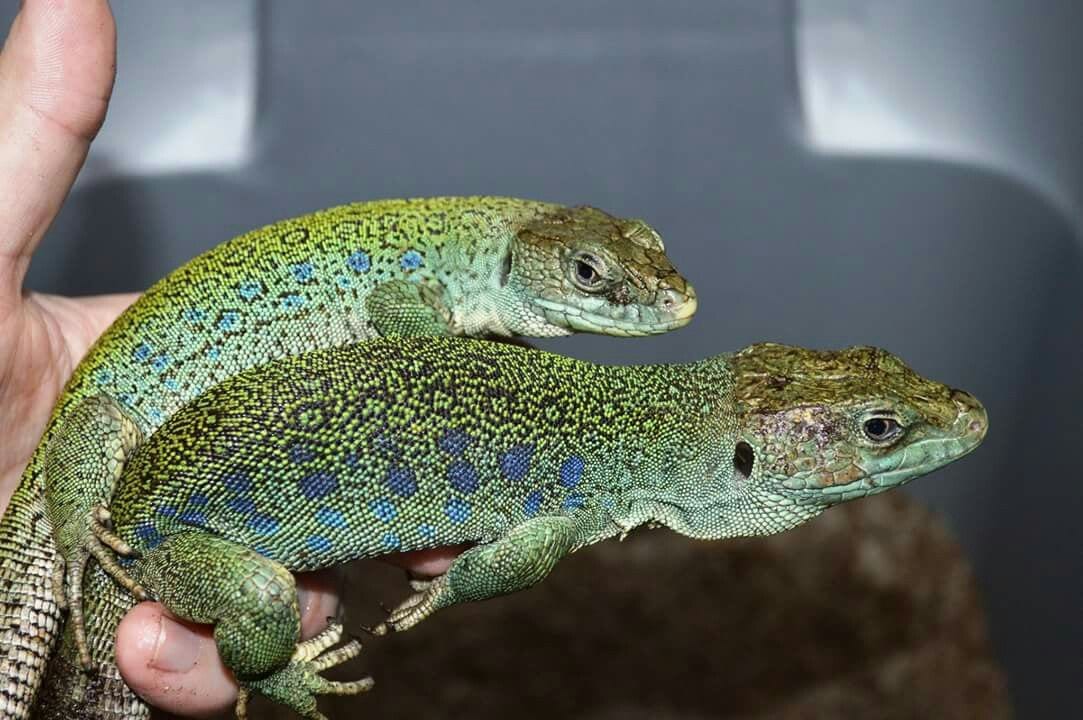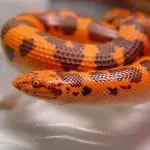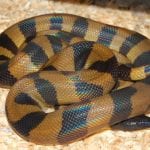Scientific Facts
| Common Name | Jeweled Lacerta, Ocellated Lizard, Jewelled Lizard |
| Scientific Name | Timon lepidus |
| Captive Lifespan | 12 to 20 years |
| Size | 30cm – 60cm |
| Mass | Over 0.5kg |
| Habitat | Shrubby, rocky, mountain meadows, open woodlands, old vineyards, coastal dunes, open agricultural landscapes |
| Country of Origin | Southwestern Europe |
Physical Description
Being one of the largest members of the Lacertids family, adults Timon lepidus are known to reach up to 3ft (90cm) in length.
In most cases, though, the size of these lizards averages between 0.98ft – 1.97ft (respectively, 30cm – 60cm), with the tail accounting for about 2/3 of the total body length.
A Jeweled Lacerta hatchling’s body size is as small as 4 – 5cm (1.5 – 2 inches), excluding the tail. Young Jeweled Lacertas are grey, brown or green in color, with white or yellowish spots all over. More often than not, the spots of the young are black-edged.
When it comes to the mass of adult Jeweled Lacertas, they usually weigh over 1.1Ib. (0.5kg).
Even though the dorsal background color of adults is typically green, sometimes Jeweled Lacertas are also colored in brownish or grey.
Living up true to their name, the brightly colored, fairly slim bodies of Jeweled Lacertas display intricate patterns, located on the backs of these reptiles. These bold patterns resemble an exquisite bijou, often arranged in interconnected rosettes, alongside distinct blue spots on the sides of the body. These spots reflect the UV spectrum light, making the Jeweled Lacerta resemble a masterpiece of all-natural jewelry. The undersides of these lizards’ bodies vary from yellowish to greenish.
Jeweled Lacertas possess strong, thick legs, long toes, and long tails, the toes ending with curved, long claws.
Male Jeweled Lacertas have quite enormous heads, as compared with females, and they are generally larger in size. Also, males tend to be brighter in color.
Types
Timon lepidus is found across the major part of the Iberian Peninsula, northwestern Italy, as well as Southern France. Depending on their distribution in the wild, there are several subspecies of Timon lepidus.
Recognized for its commonly darker patterns, Timon lepidus ibericus inhabits the northwestern Iberian Peninsula. Timon lepidus nevadensis occupies southeastern Spain.
Timon lepidus oteroi is distributed across Salvora Island in Galicia.
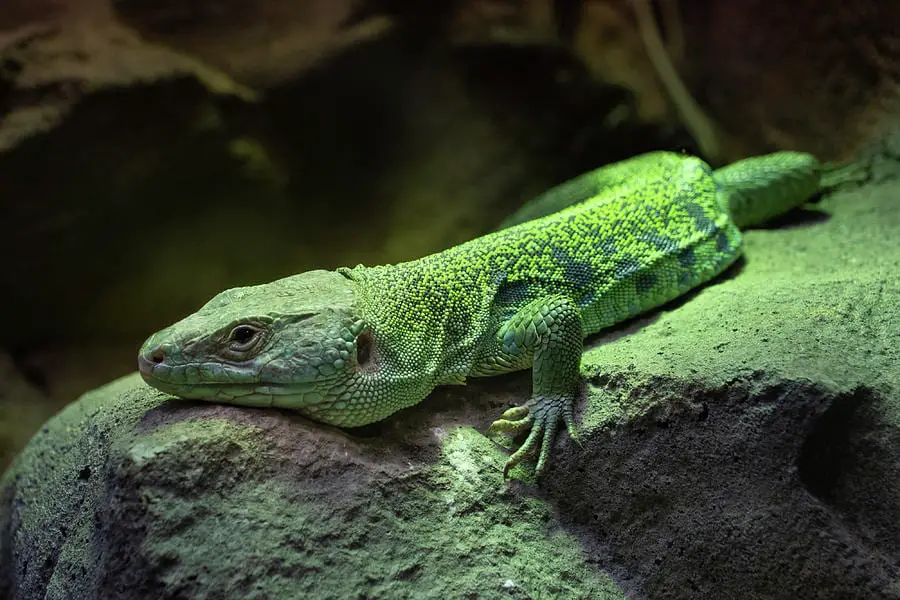
Habitat & Lifespan
Jeweled lacertas are known to occupy a wide range of habitats, varying from cultivated to wild habitats, usually located up to 2100m above sea level. Rarely can these lizards be found at higher altitudes?
Jeweled lacerta lizards prefer bushy areas that are rather dry, such as old vineyards and olive groves, open woodlands, as well as open sandy, rocky areas.
Although these lizards can be typically found on the ground, it is not uncommon to spot them on high rocks or up in the trees, as these creatures are great at climbing. Being highly skilled at burrowing, jeweled lacertas sometimes dig holes or simply make use of an abandoned rabbit burrow.
Occasionally, jeweled lacertas can be also spotted to bask on roadsides.
While the native habitat of jeweled lacertas in the wild spans across France, Portugal, and Spain, there are talented and dedicated breeders who are engaged in the captive breeding of jeweled lacertas in North America. Captive Timon lepidus lizards can live for between 12 – 20 years on an average.
Behavior
If you are to come across a Jeweled lacerta in the wild, you will most probably only be able to get a fairly quick glimpse of this beautiful, colorful creature, as it will scamper off in the blink of an eye as soon as a human is to come into view.
In general, wild and captive jeweled lacertas alike have the reputation of being very active and very inquisitive. Renowned for their passion for digging, captive jeweled lacertas’ specialty is to move their cage furniture around, and any live plants rarely stand any chance of survival along these gifted burrowers.
The way these lizards find food is to hunt on the ground, where insect prey is plentiful. Jeweled lacertas are diurnal, meaning that it is during the daytime when they are most active.
Although jeweled lacertas in the wild avoid any close contact with humans, their captive-bred counterparts are known to lose the fear of humans, as these lizards are fully capable of learning to associate human interaction with food, so that the very view of the keeper provokes positive associations.
Housing
Although there are recorded cases of male Jeweled Lacertas reaching 35+ inches, most males typically do not exceed 24 inches in length. For housing a single male, caregivers need to make use of a cage that is at least 4ft x 2ft x 3ft. (respectively, a tank that is at least 40 gallon).
As female Jeweled Lacertas usually reach up to 16 – 20 inches in length, a single female will require a smaller cage than a male, with the recommended minimum measuring at 3’x2’x18’.
It is highly recommended to opt for a front opening cage. If you utilize a standard open-lid cage, your Jeweled Lacerta pet might think you are a predator due to approaching it from above.
For keepers planning to construct a front opening vivarium, it is best to add some form of a litter dam, or else, every time you open the doors, the litter may easily come pouring out.
It is highly recommended that you avoid utilizing any water feature as part of a Jeweled Lacerta pet’s cage. These active burrowers will quickly fill just about any water body with the substrate while engaged in their daily digging practices.
Juvenile Jeweled Lacertas can be kept in smaller cages than adults (a 20-gallon tank should do just fine), as they are quite tiny before they turn at least 9 months old. As a rule of thumb, make sure that the size of the cage is as deep as the Lacerta’s total body length (tail included) and twice as wide as the juvenile’s body length (tail included).
House male and female Jeweled Lacertas in separate cages. You should only house them together for breeding purposes. Since Jeweled lacertas are recognized for being very food-aggressive, and nonetheless, quite rough during their mating season, it is best to keep them alone as to avoid any possible trouble.
Juveniles jeweled lacertas need to be housed in separate cages. It is often the case that a male in the group of juveniles is to become dominant, with a tendency to kill the rest of the juveniles.
For Jeweled Lacerta caregivers who are determined to keep multiple of these lizards together, the only sensible option is to at least use caging that is significantly larger than the recommended minimum. Doing so does not guarantee trouble-free cohabitation but certainly increases the probability of such.
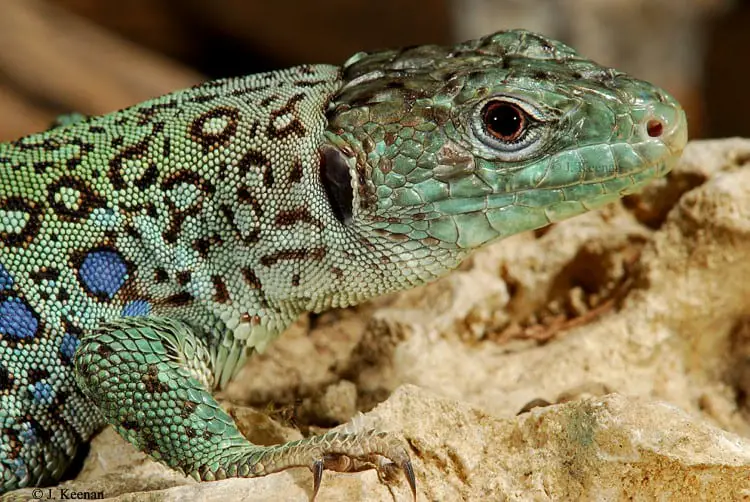
Substrate
Being burrowers by nature, choosing an appropriate substrate for your Jeweled Lacerta pet is crucial. The recommended substrate minimum is at least 6 inches.
Caregivers can utilize coco mulch, play sand, and potting soil, or any combination of two or three of these jeweled lacerta-friendly substrates. In any case, it is best to ensure that the substrate is deprived of small particles as these can be easily ingested, leading to possible harm. A combination of Forest floor and repti-bark can make a wonderful choice, especially as this combo makes up for promoting moderate humidity after misting/spraying with clean water.
The substrate should be moist enough at all times to ensure that it can hold a small burrow or den for the purpose of keeping the captive jeweled lacerta lizard comfortable, happy, and healthy for a long time.
Hatchlings should best be kept on newspaper or paper towels. In such a case, you will need to change the substrate about three times weekly. When still juveniles, it is best to keep avoiding the use of any substrate consisting of small particles, as it can lead to impaction.
Avoid reptile liners. This type of substrate can easily catch the lizard’s claws, leading to unwanted issues in return.
Temperature, Lighting & Humidity
Being native to temperate regions in Europe, Jeweled Lacertas do not tolerate or require extreme temperatures in order to thrive.
When setting up a suitable cage for captive Jeweled Lacertas, caregivers need to dedicate ½ of the cage for creating a warm side, with the other ½ of the cage utilized for creating a cool side. Between the warm and the cool sides, temperatures should be kept within the 85 – 75 Fahrenheit range.
As these lizards do require a basking area, the temperatures in this area should be maintained between 90 – 95 degrees Fahrenheit. In order to allow for your Jeweled Lacerta pet to thermoregulate properly, it is best to arrange basking areas at various heights.
Jeweled lacerta lizards are diurnal creatures, and as such, they do require UVB light. For this purpose, a Mercury vapor bulb should work excellent, as it will work as an all-in-one source for providing UV, heat, and light in the warm side of the vivarium. A 100W bulb should do great, lasting for about 12 – 18 months, as long as it is handled carefully.
On the cool side, you want to keep temperatures at about 75 degrees Fahrenheit, which is actually average room temp. You can achieve the desired temperature range by utilizing a low wattage halogen or incandescent light bulb, such as a 75W halogen bulb.
In general, Jeweled Lacerta caregivers do not need to make use of any additional heat source at night, unless the temperatures in your area of residence fall lower than 70 degrees Fahrenheit in the nighttime.
In the wild, Jeweled Lacertas are exposed to photoperiod fluctuations in temperatures and light due to seasons in their native habitat changing. With this in mind, captive Jeweled Lacertas are best to be provided with similar conditions, although doing so is only imperative when it comes to keepers who intend to breed and/or hibernate their lizards.
Jeweled Lacertas require moderate humidity of about 50%. The needed humidity for hatchlings can be provided by simply misting in the vivarium on a daily basis. For older Jeweled Lacertas, misting is required only a few times weekly. Do never spray at night when the lizard’s heat lamp is OFF, as not to compromise your pet’s health.
Utilizing a shallow water bowl is extremely helpful for keeping humidity levels at optimal rates.
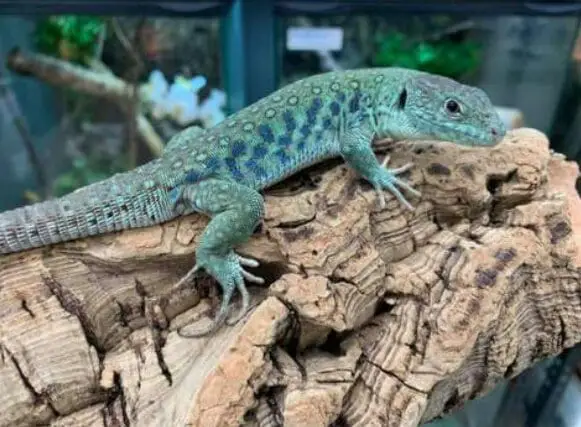
Diet
The diet of Jeweled Lacertas primarily consists of large insects, with some of these lizard’s favorite delicacies being beetles.
Occasionally, Timon Lepidus lizards also tend to take small mammals, frogs, and even other small reptiles. Snacking on robs bird’s nests is also a welcome treat for wild Jeweled Lacertas.
Although the main food preferences of these lizards are about 75% – 85% carnivorous, it is not uncommon for adult Jeweled Lacertas, and especially those occupying dry areas, to sometimes feed on plant matter and fruit.
Eating Habits
Every Jeweled Lacerta caregiver is to agree that one of the funniest parts about taking care of this type of lizard sums down to the feeding routine.
When still getting used to their enclosure, as well as to their owners, Jeweled Lacertas tend to be quite shy, but once they overcome their initial shyness, keepers can fully enjoy these lizards’ legendary temperament when it comes to food. These creatures are very much food-motivated!
Food should be distributed during the day, and the lizard should be let to hunt down its prey.
Captive Jeweled Lacertas will happily feast on garden snails, superworms, red wigglers, darkling beetles, and dubia roaches, among other invertebrates.
Also, silkworms, hornworms, and crickets will be more than welcome to establishing a well-working feeding routine based on these lizards’ eating habits.
Occasionally, you can offer waxworms, tiny pieces of boiled chicken, or butter worms as treats.
If you are able to obtain insects, such as grubs, beetles, and/or grasshoppers from any suitable area outdoors, then do not hesitate to offer them to a Jeweled Lacerta, as long as you are 100% sure that the area from which you obtain these insects has not been treated with any harmful chemicals like pesticides.
Mind that Jeweled Lacertas really love to hunt their prey, so they typically tend to be less fond of worms than other more fast-moving insects, like crickets.
Larger Jeweled Lacertas will also gladly eat small amounts of fruit but only sweet, ripe fruit, like bananas. It is best to mash the fruit with a fork prior to offering it to your Jeweled Lacerta. Other suitable fruits include mango, peaches, strawberries, grapes, and apples, among others.
If your Jeweled Lacerta does not seem to receive fruit very well, do not let this stop you from any further attempts of introducing fruit into your pet lizard’s feeding routine. Just try with another fruit, and also, make sure your lizard is at least 2 years old since the young are definitely more carnivorous.
Last but not least, fruit should make up for no more than 25% of the total food you offer to your captive Jeweled Lacerta.
Most of the days, all food should be dusted with a calcium supplement. Every now and then (biweekly), keepers should use calcium or vitamins containing supplemental D3 instead of the regular dusting with calcium alone.
Sleeping Habits
Jeweled Lacerta lizards are active during the day and typically rest during the night. It is throughout the day when these creatures feed and explore their surroundings.
Jeweled Lacertas in the wild is capable of switching to hibernation mode in the case the temperatures drop low in the winter. It is only and solely the drop in temperatures that causes hibernation without any other further assistance or preparations. These lizards can hibernate on their own, or they can be intentionally hibernated, especially when it comes to breeding purposes.
When in hibernation, Jeweled Lacertas do not fall into deep, immovable sleep. They will still move and eat, but they will do so a lot less than usual. Also, they will continue to bask, even when hibernating.
In order to avoid hibernation, caregivers should simply keep the temperatures within the lizard’s enclosure stable, the same as in the summer season, all-year-round.
Water
It is imperative that a bowl of fresh, clean water is provided for captive Jeweled Lacertas at all times. It is best to offer a relatively large, shallow bowl, switching to a bigger bowl as the lizard grows.
Positioning a water bowl the right way is also important, or caregivers may find it quite painful keeping up with these lizards’ burrowing pace on a consistent basis, requiring the water bowl to be frequently cleaned because of so much substrate getting inside.
Mind that was regularly spraying/misting the substrate with clean water is really important, as sometimes, Jeweled Lacertas may stop drinking water altogether, intuitively waiting for rain and other natural conditions to provide them with the much-needed moisture.
However, do not forget that these lizards are NOT tropical, so you must not overdo the spraying/misting routine as not to bring humidity over the optimal levels.
Development and Reproduction
With Jeweled Lacertas, the breeding season begins in late spring or early summer. Males are known for being quite territorial during the mating season, and they often get into fights.
About 3 months after successfully mating, females are to lay up to 22 eggs (typically, laying 8 – 12 eggs is the norm) in total, usually at some point in June or July. The eggs are to be hidden under logs or stones or burrowed in loose, damp soil or leaf litter. Jeweled Lacertas inhabiting dry areas are known to lay fewer eggs.
Within 8 and up to 14 weeks after being laid and hidden, eggs are to hatch, and the tiny lizards will get down to explore their surroundings. Juveniles reach sexual maturity once they turn two years old.
How to Breed
- For breeding Jeweled Lacertas, hibernation is required.
- Caregivers can initiate hibernation by gradually dropping down the temperatures within the enclosure. This should take place at the beginning of the winter season, slowly reaching steadily low temperatures of 40 – 50 degrees Fahrenheit.
- The hibernation period lasts for 60 and up to 90 days.
- Males and females are ready for breeding once they turn 2 – 3 years old.
- Mating is expected to occur within 1 week and up to 1 month once the hibernation period is over.
- Please, mind that the mating habits of Jeweled Lacertas sometimes tend to be quite violent. It is not uncommon for males to injure females during the course of mating, or even to kill them. All of that being said, keepers must make sure that the pair of Jeweled Lacertas to be mated is in perfect health.
- About 7 days prior to laying the eggs, the female Jeweled Lacerta is to remain restless, apart from frequently digging. It is often the case that the female will stop eating, too.
- Breeders need to provide a laying box for the female to lay her eggs.
- Adult Jeweled Lacertas may be tempted to eat the eggs. Because of this, breeders need to keep a close eye on the mature lizards. Ultimately, the eggs should be removed from the enclosure and placed in a separate one as soon as feasible.
- Within a single season, female Jeweled Lacertas can lay up to three clutches.
- Breeders need to incubate the eggs using an appropriate medium. Vermiculite damped with clean water makes a wonderful incubating medium. Damp the Vermiculite with as much water as the weight of the Vermiculite itself, following a 1:1 ratio. Next, keep the incubating medium along with the eggs at 82 – 86 degrees Fahrenheit.
- Eggs should hatch within 90 – 120 days, with the incubating medium and optimal temperatures within this period requiring proper maintenance.
- Baby Jeweled Lacertas are as tiny as about 2.5 inches. They eat the same food as adults do, and they require the same temperature/humidity rates as adults, with the major difference that the provided food items should be smaller in size in general.
Handling
It is often the case that Jeweled Lacertas are compared with Tegus, and even advertised as Mini Tegus versions. Although Jeweled Lacertas and Tegus lizards do share certain similarities, with their bodies’ structure being very much alike, they are also quite different, and that’s especially true when it comes to their temperament, handling included.
While Tegus lizards are known as being easy to tame and enjoy handling in general, this is not exactly the case with Jeweled Lacertas. Lacerta’s are much more skittish, naturally shy, and therefore, they require more time and patience to be tamed down.
Fortunately, it is fully possible to tame and handle a Jeweled Lacerta successfully, but then again, this only happens with time and practice. The best incentive for taming down a Jeweled Lacerta is none other but food. As these lizards are extremely food-motivated, they can be brought into seeing their caregiver as the “food lord,” or “food god,” so to say.
Mind that when just settling in their new enclosure, Jeweled Lacertas may require several months before overcoming their shyness. Within this period, handling is best to be limited, as not to scare your lizard pet even more.
You can start briefly handling your Jeweled Lacerta gradually after the initial period of settling in has passed. Use the fact that this type of lizard is food-motivated as your best advantage.
Do not grab or otherwise restrain your Jeweled Lacerta. Instead, put your hand under the lizard’s body and gently lift it.
In the case you have no other handling option, you can restrain a Jeweled Lacerta in the safest way possible by dropping a dishtowel onto it, and then seizing it quickly and confidently, yet carefully and without squeezing its gentle body at any cost.
Mind that handling-related stress can lead to your Lacerta’s tail dropping. Also, these lizards may put up quite some fuss when handled. However, they do recover quickly from such type of stress.
Another way to calm down your Lacerta for handling purposes is to cover its face lightly, and/or to dim the lights a bit.
Remember that patience is key. There is no use to force your Lacerta, as it is only time that will teach your pet not to be shy off from handling.
How to Treat and Prevent Possible Health Issues
Jeweled Lacertas are quite hardy creatures. When provided the right conditions by their caregivers, these lizards will rarely, if ever, encounter any health issues.
It is important to counteract impaction, which tends to be common among these lizards and can be caused by a number of factors, including an unsuitable substrate, poor diet, and/or ignored or improper hydration. Then again, following the basic enclosure, temperature, lighting, and humidity recommendations should keep impaction-related issues at bay.
Annual check-ups by qualified vets will help caregivers to catch and treat any unwanted issues in a timely manner.
If you notice that the eyes of your Lacerta seem blurred instead of bright, or if the lizard is suspiciously inactive for an extended period of time, or if your pet lacks appetite, consult with a qualified vet as soon as possible.
Make sure to powder Calcium supplement onto meals. Also, you can choose to prepare a mixture consisting of 4mg Calcium lactate and 1ml of Vitamin D3 per 1 liter of water. This mixture should be administered every two days.
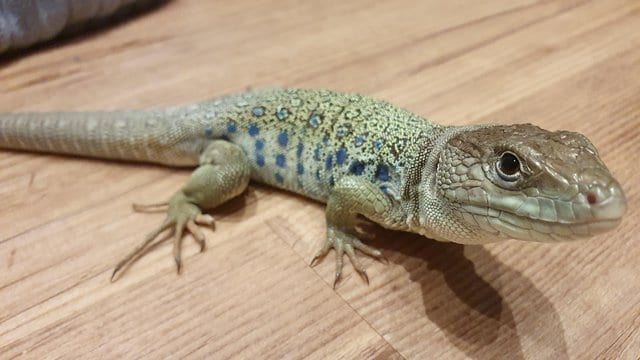
Possible Dangers to Humans
Jeweled Lacertas are non-venomous, and their teeth are also quite small, so even in the case the lizard is to bite the caregiver, no serious dangers to humans’ health are posed.
Availability: How to Get a Jeweled Lacerta?
You only want to get your Jeweled Lacerta pet from reputable breeders/ retailers. Do never get one from the wild, since apart from carrying possible health issues, such as parasites, these lizards are protected as near threatened species. Also, export is forbidden.
You want to look for a Lacerta with bright, clear, open eyes. Also, check out if the toes appear healthy if the nostrils are clean and if the mouth looks clean and pink in color, as these are all signs of good health.
If you notice that a Jeweled Lacerta had lost its tail tip, but the spot is nicely healed, there is no reason to worry. However, future sheds should be monitored.
It will be hard to tell apart male hatchlings from female hatchlings simply by looking at them, but with adults; there are obvious differences. The colors of mature males are much more robust, vivid, and bright, and their heads are significantly larger than the females’.
Even though the coloration of female Jeweled Lacertas is paler, more muted than that of males, the pattern is still obvious, and both sexes are equally adorable.
Fun Facts
Jeweled Lacertas used to be a significant part of the traditional Spanish cuisine in the Extremadura region. The lizards were commonly prepared by being sliced into pieces and then fried in olive oil, initially stewed on a slow fire, ending up as the traditional guisado dish.
Nowadays, the Jeweled Lacerta is protected according to Spanish law. Both the capture and the trade of wild lacertas are strictly forbidden.
The distinct, pixelated scales of Jeweled Lacertas are referred to by some scientists as a “computer game” brought into life. That’s because of the way these beautifully patterned scales continually update throughout the lizards’ lifespan by following a computer-like algorithm. These reptiles are considered the living embodiment of a phenomenal model known as cellular automation. The cellular automaton model was used to explain/simulate the firing of neurons, as well as the spread of wildfires by John Conway.
It isn’t before Jeweled Lacertas turn four years old that their pixelated patterns become permanent.
How to Take Care of a Jeweled Lacerta
Jeweled Lacertas are not particularly arboreal. However, they do climb, so it is best to provide them with platforms that suitable for this purpose, such as cork bark pieces, rocks, large branches, and/or driftwood.
If caregivers are to use rocks, only very light rocks, such as slate, should be best utilized. If weighty rocks are added within the enclosure, they can easily crush your burrow-loving Lacerta. If weighty rocks are utilized, make sure that the rocks are to be well-secured, resting on the bottom surface of the enclosure, and not on the surface of the substrate, so that your pet will not end up crushed.
Some of the most wonderful hides, thanks to the in-built caves, are none other but cinder blocks, best to be partially buried.
It is a great idea to use a suitably-sized Tupperware container for the purpose of creating the much-needed moist hide box for your pet. Certainly, you can use other types of hiding boxes. The point is to place some damp moss inside, and then bury the hide box in the substrate, so that only the hole located in the lid is to remain exposed.
A well-moist hide box is not only suitable for allowing your Jeweled Lacerta to hide and feel comfy as needed, but it is also extremely useful during shedding.
When appropriate hide boxes are utilized, caregivers may just as well notice that their Lacerta will not dig as much as it will otherwise do in the absence of hiding boxes.
Jeweled Lacertas are not well-known for their docility. However, if you intend to keep this type of lizard as a pet, you are fully capable of teaching your Lacerta to be happy whenever interacting with you, and that’s achievable by allowing your pet to associate you with feeding time, as well as with positive interactions.
FAQs
Do Jeweled Lacerta Lizards Bite?
Jeweled Lacerta lizards can bite. However, they rarely ever do so, except for during the breeding season. Even if a Jeweled Lacerta is to bite, this is barely felt by humans due to these lizards’ quite small teeth, practically incapable of causing any serious harm.
Is Jeweled Lacertas Aggressive?
No, Jeweled Lacertas are not aggressive, except for males typically becoming more hostile during the breeding season. The truth is, Jeweled Lacertas are actually quite shy. However, if treated badly by their owners and/or improperly fed, they may become more aggressive than they naturally are.
Can a Jeweled Lacerta Recognize the Owner?
Yes, it is fully possible for a captive Jeweled Lacerta to learn to recognize his/her owner over time. For this purpose, the lizard should be treated with patience, and food should be used as the major motivation for bringing positive connotations about the caregiver.
Are Jeweled Lacerta Lizards Endangered?
Fortunately, Jeweled Lacertas are not among the most endangered animal species. Ever since 2011, Jeweled Lacertas have been under protection in Spain, after being listed as near threatened on the IUCN Red List of Threatened Species. Nowadays, Jeweled Lacerta lizards’ populations in the wild are on the rise; however, both trade and capture of wild Lacertas remain strictly forbidden.
Is Male Jeweled Lacertas more Beautiful than Females?
Male Jeweled Lacertas has earned the reputation of being more beautiful than females, according to some caregivers and experts alike. However, this is not accurate, since both females and males are equally lovely in their very own ways. It is true, though, that males are more intensely colored, and in particular, the green tint is more distinct than that of females.
How Often Do Captive Jeweled Lacertas Need Feeding?
Jeweled Lacertas have a voracious appetite, and they will rarely turn away from any appetizing treat provided by the caregiver. An adult male Jeweled Lacerta can eat about 20 large-sized crickets offered 2-3 times a week, without the risk of becoming overweight.
What Fruit and Treats to Feed my Jeweled Lacerta Pet with?
Fruit should make up for about 25% in the diet of an adult Jeweled Lacerta. You can feed your Jeweled Lacerta pet various fruit and other treats, apart from insects, such as bananas, strawberries, eggs, honey, yogurt, apricots, applesauce, kiwis, mangoes, grapes, cherries, and organic, natural jam.
Do Jeweled Lacertas Require High Humidity?
No, Jeweled Lacerta lizards are not tropical creatures, and therefore, they thrive in moderate humidity, averaging between 50% and up to 70%. However, caregivers do need to sprinkle the enclosure with clean, room temperature water every morning to ensure their pet’s perfect health and well-being.
Can I Keep Multiple Jeweled Lacertas Together?
Jeweled Lacertas tend to encounter cohabitation issues. However, it is not impossible to keep multiple captive-bred Jeweled Lacertas together, as long as the enclosure is large enough to limit any possible trouble. Also, daily monitoring is recommendable, so that in the case of cohabitation problems, owners can take appropriate measures by separating the conflicting lizards.
Does Jeweled Lacertas Need UV Lighting?
Yes, captive Jeweled Lacertas need additional UV lighting, since they cannot “bathe” in the UV light any other way when kept as pets indoors. The UV light does not only make up for these lizards’ amazing patterns to become more distinct, but it is also crucial for their health and proper development. In the case, parents are not supplied with UV light adequately; the young are quite rachitic.

